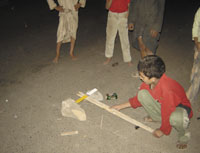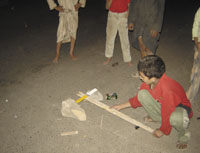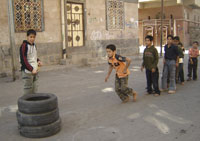
Yemeni traditional games: Remembering our childhood [Archives:2007/1100/Last Page]
November 5 2007
 |
 |
 |
fatimafnfr@yahoo.com
Without disrupting their specialized small world, children still enjoy their childhood by playing traditional games. Traditional Yemeni children's games are many, but some have disappeared while others remain popular. Fatima Al-Ajel explores these various types of traditional games in a series, beginning with boys' games.
Many games in Yemen, and this may be true in many other countries as well, are played especially by boys as, for one reason or another, girl players are rare or not allowed to play them.
Many childhood specialists describe boys' games as physical and requiring more effort while other games are played violently. The nature of boys' games creates competition and leadership among them during play.
Children the world over play various versions of the same games, such as jump rope, marbles, tag, spinning a top, hopscotch, jacks and card games, with quite a few differences in game rules. In some games, there are also different songs with the same melody that are sung while playing.
Most boys' games are played using sticks, stones, balls, marbles, paper, etc., because they are the only means available to children, as they are simple items and mostly from the children's surrounding environment. In the following game, Yemeni boys basically play it with two sticks and stones.
Dharab Al-Hadwi, as it's called in Sana'a, is a traditional game played with two sticks and two stones. Dharab Al-Hadwi is classified as a boy game because few girls rarely play it. Previous generations have played it over the years; however, it's not popular today among most of Yemen's new generation, with the exception of children in some villages. As such, this game is considered one of Yemen's folkloric games.
How it's played
In Dharab Al-Hadwi, children are divided into two teams. Each side has two straight sticks, one longer than the other in order to measure distance, and two large stones. The game is played in an open field.
One player begins by throwing the smaller stick as far as he possibly can and then the distance between the thrown stick and the positioned stones is measured. Subsequent players do the same. Whoever throws the small stick farthest from the stones wins.
Zaragaf, or marbles, is a well-known game worldwide and especially popular among boys. Marbles traditionally have been played in countries all over the world. In Yemen, there are many different ways to play, between either two competitors or a group.
This game creates competition between children to earn more marbles, as they start with only a few, the number of which varies from two to 10 or more, depending on the number of players and the agreement between them. Marbles are different colored and of two sizes. The shooter marble is called magza'a and is used to hit the smaller ones.
How it's played
Children draw a circle, triangle or line, its size depending on the number of marbles the boys have, and then place all of their marbles inside it. They designate a marble as the goal or center. The one who shoots the center marble without moving or touching the others wins all of the marbles. Alternatively, players compete for marbles by knocking the others out of the circle.
The player whose marble is nearest to the line goes first. His goal is to roll his marble and knock other marbles out of the circle or triangle or across the line. The winner is the player who takes all of the marbles from the other players. The game continues until all marbles are gone.
Some boys skilled at playing Zaragaf use the game as a business in order to sell marbles and earn money. For example, a boy with lots of marbles will sell them to other children at less cost than they might buy or find in shops.
Children do their best to buy marbles, even if they haven't enough money. “I buy a few marbles and then play until I get more from Zaragaf. I then sell some to other children and keep some to play and earn more money,” 10-year-old Zaragaf player Abdulsalam Al-Radaa'i explains.
Min Kobet Al-Tayyar is an interesting boys' game known in most Yemeni governorates such as Sana'a, Aden, etc., where the game's name mostly is the same, but the rules differ according to the players' different dialects and environments.
In his paper on Adeni folklore, Ahmad Al-Sa'eed mentions that Min Kobet Al-Tayyar is a traditional game in Aden. Additionally, there are at least 57 other games played by Adeni children, with different rules and songs than in Sana'a or other cities.
How it's played
Min Kobet Al-Tayyar requires players to run quickly and get a “house,” which is a circle each player draws on the ground. One circle is left empty. One player stands in the middle of all of the others and play commences when the leader begins singing the game song, which is the game's name.
At the end of the song, the leader names a certain player's circle, which must be empty, so players must listen to the song carefully and move about to change their circles.
The player who can't get to a circle is the loser and therefore, punished. Punishment in such game is that every player hits the loser's hands three times, or more or less, as agreed at the beginning. Afterward, another player leads the game and so on.
This game makes children good listeners and they must be active.
Qasia'
Qasia' are empty cans children use as a goal. This game requires players to form two teams of at least three players, who must follow many rules in order to win. The game is played in an open field because players need space to run around.
How it's played
Before commencing play, both teams plan how to mislead the opposing team. Players then draw lots to see who will start the game. The nature of the game is that if the other team can get to the goal and score with a ball without letting the shooting team touch them, they win. However, the shooting team can prevent the other team from reaching the goal by hitting them with a ball and then they win.
Players in this game create tricks to manage the play. For example, the shooting team tries to hide the ball and then runs to hit one of the other team members, causing the players to protect the goal and not allowing the other team to reach the goal. If a player from the other team is hit, he's out of the game, so the other team's numbers will decrease, which helps the shooting team win the game.
——
[archive-e:1100-v:15-y:2007-d:2007-11-05-p:lastpage]


